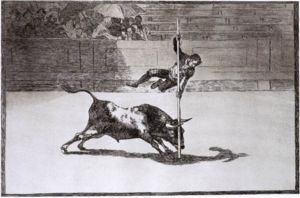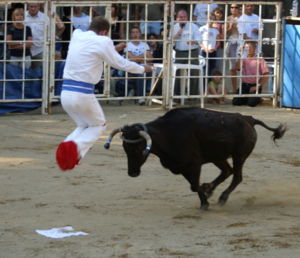
Bull-leaping
Encyclopedia


Levant
The Levant or ) is the geographic region and culture zone of the "eastern Mediterranean littoral between Anatolia and Egypt" . The Levant includes most of modern Lebanon, Syria, Jordan, Israel, the Palestinian territories, and sometimes parts of Turkey and Iraq, and corresponds roughly to the...
, Bactria and the Indus Valley
Indus Valley Civilization
The Indus Valley Civilization was a Bronze Age civilization that was located in the northwestern region of the Indian subcontinent, consisting of what is now mainly modern-day Pakistan and northwest India...
. It is often interpreted as a depiction of a ritual
Ritual
A ritual is a set of actions, performed mainly for their symbolic value. It may be prescribed by a religion or by the traditions of a community. The term usually excludes actions which are arbitrarily chosen by the performers....
performed in connection with bull worship. This ritual consists of an acrobatic leap over a bull; when the leaper grasps the bull's horns, the bull will violently jerk his neck upwards giving the leaper the momentum necessary to perform somersaults and other acrobatic tricks or stunts.
Iconography
Younger (1995) classifies bull-leaping depictions as follows:- Type I: the acrobatAcrobaticsAcrobatics is the performance of extraordinary feats of balance, agility and motor coordination. It can be found in many of the performing arts, as well as many sports...
approaches the bull from the front, grabs the horns, and somersaults backwards - Type II: the acrobat approaches the bull from the front, dives over the horns without touching them and pushes himself with his hands from the bull's back into a backward somersault
- Type III: the acrobat is depicted in mid-air over the bull's back, facing the same way as the animal
The Type III depictions are often found in Late Minoan IIIB artwork (14th to 13th centuries BC). Frescoes in Tell el Dab'a (Avaris, Egypt) dating to the 18th dynasty (16th to 14th centuries BC) show similar designs besides genuinely Egyptian motives, for which reason they have usually been ascribed to Minoan-taught Egyptian craftsmen (rather than to Minoan ones directly). They could also have been included as palace decorations because the palace was built for an Aegean princess diplomatically married to a Hyksos pharoah.
Other examples of bull-leaping scenes have been found in Syria
Syria
Syria , officially the Syrian Arab Republic , is a country in Western Asia, bordering Lebanon and the Mediterranean Sea to the West, Turkey to the north, Iraq to the east, Jordan to the south, and Israel to the southwest....
, such as a cylinder seal
Cylinder seal
A cylinder seal is a cylinder engraved with a 'picture story', used in ancient times to roll an impression onto a two-dimensional surface, generally wet clay. Cylinder seals were invented around 3500 BC in the Near East, at the contemporary site of Susa in south-western Iran and at the early site...
impression found in level VII at Alalakh
Alalakh
Alalakh is the name of an ancient city-state near modern Antakya in the Amuq River valley of Turkey's Hatay Province.Now represented by an extensive mound, the name of the modern archaeological site is Tell Atchana.-History:...
(Old Babylonian
Old Babylonian
Old Babylonian may refer to:*the period of the First Babylonian Dynasty *the historical stage of the Akkadian language of that time...
period, 19th or 18th century BC) showing two acrobats performing handstands on the back of a bull, with an ankh
Ankh
The ankh , also known as key of life, the key of the Nile or crux ansata, was the ancient Egyptian hieroglyphic character that read "eternal life", a triliteral sign for the consonants ʻ-n-ḫ...
sign placed between them, another seal belonging to a servant of Shamshi-Adad I
Shamshi-Adad I
Shamshi-Adad I Shamshi-Adad I Shamshi-Adad I (fl. late 18th century BC (short chronology) was an Assyrian king. He rose to prominence when he carved out an empire encompassing much of Mesopotamia, Syria and Asia Minor...
(c. 1800 BC), besides other Syrian examples. Furthermore a vase was discovered in Hüseyindede in 1997, dating to the Hittite Old Kingdom (18th to 15th centuries BC).
Minoan Crete
Bull-leaping is thought to have been a key ritual in the religion of the Minoan civilizationMinoan civilization
The Minoan civilization was a Bronze Age civilization that arose on the island of Crete and flourished from approximately the 27th century BC to the 15th century BC. It was rediscovered at the beginning of the 20th century through the work of the British archaeologist Arthur Evans...
in Bronze Age
Bronze Age
The Bronze Age is a period characterized by the use of copper and its alloy bronze as the chief hard materials in the manufacture of some implements and weapons. Chronologically, it stands between the Stone Age and Iron Age...
Crete
Crete
Crete is the largest and most populous of the Greek islands, the fifth largest island in the Mediterranean Sea, and one of the thirteen administrative regions of Greece. It forms a significant part of the economy and cultural heritage of Greece while retaining its own local cultural traits...
. As in the case of other Mediterranean civilizations, the bull
Bull
Bull usually refers to an uncastrated adult male bovine.Bull may also refer to:-Entertainment:* Bull , an original show on the TNT Network* "Bull" , an episode of television series CSI: Crime Scene Investigation...
was the subject of veneration and worship
Bull (mythology)
The worship of the Sacred Bull throughout the ancient world is most familiar to the Western world in the biblical episode of the idol of the Golden Calf. The Golden Calf after being made by the Hebrew people in the wilderness of Sinai, were rejected and destroyed by Moses and his tribe after his...
. Representation of the Bull at the palace of Knossos
Knossos
Knossos , also known as Labyrinth, or Knossos Palace, is the largest Bronze Age archaeological site on Crete and probably the ceremonial and political centre of the Minoan civilization and culture. The palace appears as a maze of workrooms, living spaces, and store rooms close to a central square...
is a widespread symbol in the art and decoration of this archaeological site.
The assumption, widely debated by scholars, is that the iconography represents a ritual sport and/or performance in which human athletes literally vaulted over bulls as part of a ceremonial rite.
Contemporary bull-leaping


South West France (wine region)
South West France or in French Sud-Ouest, is a wine region in France covering several wine-producing areas situated respectively inland from, and south of, the wine region of Bordeaux...
, where it is traditionally known as the Course Landaise
Course Landaise
The course Landaise is an ancient form of bullfighting held in oval or rectangular arenas covered in sand, that does not involve any bloodshed. Experienced cows generally from the age of 2 and up to 14 years old are used instead of bulls. They are athletic animals selected from the same breed as...
(although young cows are used instead of bulls). The town of Mont-de-Marsan
Mont-de-Marsan
Mont-de-Marsan is a commune and capital of the Landes department in Aquitaine in southwestern France.Mont-de-Marsan airbase « Constantin Rozanoff » is a major installation of the French Air Force. The base includes CEAM , an air defense radar command reporting centre, and an air defence control...
in Gascony
Gascony
Gascony is an area of southwest France that was part of the "Province of Guyenne and Gascony" prior to the French Revolution. The region is vaguely defined and the distinction between Guyenne and Gascony is unclear; sometimes they are considered to overlap, and sometimes Gascony is considered a...
is renowned for its fine sauteurs or "leapers" and écarteurs ("dodgers") dressed in brocaded waistcoats. They compete in teams, attempting to use their wide repertoire of skillful evasions and acrobatic leaps to avoid the cow's charges.
The cow is typically guided by the use of a long rope attached to its horns, so that it runs directly at the performers and is restrained from trampling or goring them should they miss a trick. Although there is little to no risk to the cow in this form of contest, it is a highly dangerous sport for the human participants; a prominent Montois, Jean-Pierre Rachou, was killed in 2001 when he fell on his head after being hit by a cow.
In France the courses Landaises are held from March to October at the occasion of festivals in many cities and villages, among which:
Nogaro
Nogaro
Nogaro is a commune in the Gers department in southwestern France.-Population:-References:*...
, Mont-de-Marsan
Mont-de-Marsan
Mont-de-Marsan is a commune and capital of the Landes department in Aquitaine in southwestern France.Mont-de-Marsan airbase « Constantin Rozanoff » is a major installation of the French Air Force. The base includes CEAM , an air defense radar command reporting centre, and an air defence control...
, Dax
Dax, Landes
Dax is a commune in Aquitaine in south-western France, sub-prefecture of the Landes department.It is particularly famous as a spa, specialising in mud treatment for rheumatism and similar ailments....
, Castelnau-d'Auzan
Castelnau-d'Auzan
Castelnau-d'Auzan is a commune in the Gers department in southwestern France.-Geography:A picturesque little village on the river Gélise on a crossing of roads, east of the city of Condom in the Gers bounding the departments Lot-et-Garonne and the Landes. It benefits of a privileged situation on...
and many other places. Of course there are also national championships.
A similar but even more dangerous tradition of non-violent bull-leaping is practiced in some parts of Spain. Known as the Recortes, athletes, known as Recortadores, compete at dodging and leaping over bulls without the use of the cape or sword. Some Recortadores use a long pole to literally pole-vault over the charging animal, which is both larger than the type used in the French sport, and unrestrained by any guiding rope or similar safety device.
Another example of related sport is Jallikattu
Jallikattu
Jallikattu or Eruthazhuvuthal or Manju Virattu is a bull taming sport played in Tamil Nadu as a part of Pongal celebrations usually on Mattu Pongal day. This is one of the oldest living ancient sports seen in the modern era. Although it sounds similar to the Spanish running of the bulls, it is...
, a Pongal celebration related sporting event in Tamil Nadu
Tamil Nadu
Tamil Nadu is one of the 28 states of India. Its capital and largest city is Chennai. Tamil Nadu lies in the southernmost part of the Indian Peninsula and is bordered by the union territory of Pondicherry, and the states of Kerala, Karnataka, and Andhra Pradesh...
, India. In this sport, the participants are trying to leap onto a bull, specifically reaching for the money packets tied to the bull's horns as a prize. This ancient event has been depicted in rock art dated at least to the 3rd century BC.

